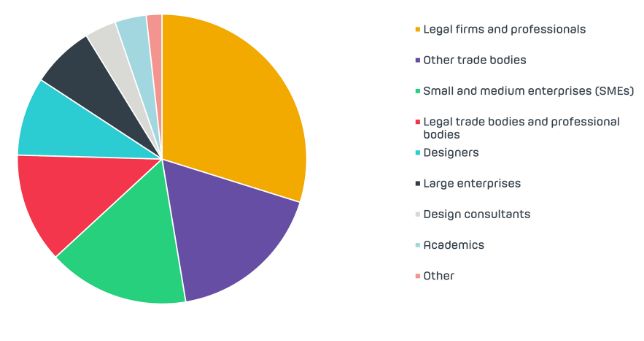Following our previous post regarding the public consultation recently carried out by the UK Intellectual Property Office (UK IPO or IPO), we have reviewed the analysis of responses from the IPO and detail these in the sections below.
The consultation has been set out under several key headings:
- Registered - search and examination
- Simplifying the designs system
- Disclosure of supplementary unregistered designs
- Future technologies
- Deferment
- Enforcement
For each section of the consolation, the government has promised to investigate the findings further and look at implementing changes where possible. It will be interesting to see what changes are introduced and how these will impact the designs system, especially in relation to the possibility of search and examination for registered deigns - which received mixed reviews from the respondents. We also believe the IPO has an opportunity to be at the forefront of protecting digital designs, e.g. animations, if it implemented an improved system which permitted the filing of better representations for digital design registrations.
Specifically, the issues identified from the consultation for further consideration, which include areas where a further consolation may take place, are:
- How to simplify the designs regime, in particular for unregistered designs
- How to improve guidance for designers, including those who do not normally engage with the government directly
- Options around search and examination
- The relationship between design and copyright law, and if there is a need for reform or guidance
- Concerns about disclosure requirements for supplementary unregistered designs, including uncertainty in relation to simultaneous disclosure
- Whether the current format requirements for how designs are represented should be updated
- How to ensure the designs system is flexible enough to support developments in technology
- Options for different lengths of deferment
- Measures that could be introduced to make enforcement easier for all rights owners
- Evidence to support views on the extension of criminal sanctions for unregistered design infringement
The consultation ran between January and March 2022 and received 57 responses, split into the following categories.

To supplement the public consultation, the IPO held stakeholder roundtable meetings and carried out a survey aimed at people having an interest in designs but who do not consider themselves experts. The responses were predominantly from lone designers (58%) and small businesses employing fewer than 10 people (22%). The survey provides an insight into how these groups think about and use design rights to support their businesses. For example, 25% indicated that the main reason for not registering their designs was due to a lack of understanding in the system while 30% indicated that cost, time and complexity acted as barriers to registration.
1. REGISTERED DESIGNS - SEARCH AND EXAMINATION
The consultation received mixed views on prior art searching for designs. Most respondents shared our view that the speed and value offered by the current design registration system are some of the main "selling points" that encourage the registration of designs.
There were many respondents who wished for some level of searching and examination to be available at the IPO to reduce uncertainty about the validity of design registrations. However, many shared our concern that such search and examination could result in increased costs and delays to registration, making the UK a less attractive place in which to register designs.
While there was some support for the use of AI searching tools to help provide pre-registration searches without causing delays, its reliability was questioned particularly in relation to its inability to identify unregistered design rights.
On the other hand, there was support for making AI tools available to the public and this tied into a general felt need for a robust and user-friendly search tool to be available on the IPO website.
Many respondents commented positively to a two-tier system similar to the one offered by IP Australia and we agree that this would be preferable to having compulsory examination prior to registration. We suggested to the IPO that if examination is required prior to enforcement of the registered design, there should be the option to choose to either have the examination carried out before registration of the design or to delay examination until such time the registration is being enforced(which might never occur). In this way, the attractiveness of the traditional registration system still stands with the option of obtaining a more robust registration at the outset e.g. for high-value designs.
There were mixed views regarding bad faith provisions. Some respondents supported its introduction as they considered them as a potentially useful additional ground for invalidation while others thought that bad faith filings could be dealt with by invalidation under novelty grounds and that these new provisions would only increase the complexity of the designs law.
There was limited support for introducing an opposition period as it was generally considered to add unnecessary delays to the registration of designs.
The responses included a large number of suggestions for improving the designs system including joining the World Intellectual Property Organisation's (WIPO) Digital Access System (DAS), introducing an online file inspection service, increasing the maximum description length, increasing the word limit for disclaimers and increasing the size of images.
The government will further consider options for search and examination. Stakeholder views will be sought at consultation. The government will also give consideration to joining the WIPO DAS system for designs. This will be considered as part of the IPO's digital transformation programme.
2. SIMPLIFYING THE DESIGNS SYSTEM
There was a general agreement that the UK designs system is complex and particularly difficult to navigate for smaller companies and lone designers.
Most of the suggestions on how the designs system could be simplified revolved around simplifying the overlap of unregistered design rights. It was emphasised that any changes should not reduce the scope of protection available to designers by the current rights. This is because small companies, lone designers and designers working in fast-paced sectors are particularly reliant on unregistered rights due to the costs and time required to register designs.
Some suggestions encouraged the harmonisation between different UK rights, e.g. between UK unregistered design rights and supplementary unregistered design (SUD) rights. Other suggestions encouraged the harmonisation between UK and EU design rights and further suggestions encouraged harmonisation between UK and international design rights.
However, the obligations set out in relation to unregistered designs by the UK-EU Trade and Cooperation Agreement need to be kept in mind together with the fact that significant divergence from EU design rights could impede future cooperation and agreements with the EU Intellectual Property Office.
The consultation received suggestions of consolidating design legislation into a single piece of legislation and harmonising definitions of certain terms across rights e.g. "product" and "get up". In addition to these definitions, we suggested that further clarification on what is meant by "animation" would be helpful given the increased number of clients wishing to protect their animated designs (e.g. in relation to user interfaces on apps).
The government will investigate options to simplify the designs regime, in particular unregistered designs. The government will also consider the relationship between design and copyright law, and the need for reform or guidance. The government will consider how it can improve guidance for designers.
3. DISCLOSURE OF SUPPLEMENTARY UNREGISTERED DESIGNS
Many respondents agreed that clarity is needed in relation to the disclosure of supplementary unregistered designs (SUDs). While some respondents argued that SUDs and unregistered community designs (UCDs) do not necessarily require a first disclosure in specific territories, there is no clear answer to this question as it is not specified by legislation nor has it been decided by the Court of Justice of the European Union (CJEU).
There is also little clarity around how a non-geographical, i.e. online, disclosure available in both the UK and EU should be interpreted. Given this lack of clarity, in practice our clients need to undertake the logistical challenge of carefully considering how, when and where a design is first disclosed in order to establish either supplementary unregistered design rights in the UK or unregistered community design rights in the EU.
The possibility for reciprocity between the EU and the UK in relation to design disclosure was considered by respondents, particularly considering potential divergence of UK unregistered design rights as discussed above. There were mixed views on whether the UK should consider recognising simultaneous disclosure even if the EU is not prepared to do so.
The government will consider the issue of uncertainty amongst users of the system about disclosure requirements for supplementary unregistered designs including uncertainty in relation to simultaneous disclosure. It will seek additional stakeholder views and evidence on options to address the problems raised.
4. FUTURE TECHNOLOGIES
The consultation received different views on whether the current design system is suitable to protect 4D designs given the non-permanent nature of 4D-printed products.
Some respondents considered the terms "design" and "product" in design law to be sufficiently broad and flexible to cover future technological developments and that it is possible to protect 4D designs providing no parts were added or removed. However, we raised the concern that that there are instances where part of a design may look as if it has been removed and suggested that there should be special provisions for protecting 4D designs.
Certain respondents also considered the infringement of 3D and 4D printed products and to what extent consumers may try to claim a private, non-commercial use defence if they print infringing products.
The need for the UK design system to cover virtual designs was also discussed. Respondents mentioned the need for designs to cover the potential market of virtual clothes, "skins" and electronic reproductions of physical designs e.g. via non-fungible tokens (NFTs), and discussed the need to consider the effects of blockchain technology on ownership, disclosure, infringement and enforcement of design rights.
The responses supported the idea of design protection to cover virtual and alternative designs such as animations, icons, graphical user interfaces (GUIs) and projected or holographic designs. We suggested to the IPO that removing the image pixel size limit would improve protection for GUIs as would the ability to upload animated videos in the design filing. This would overcome many shortcomings in relation to trying to protect a digital animation via a series of still images and could put the UK at the forefront of allowing digital designers to protect their designs.
Other respondents also urged the IPO to facilitate the filing of digital representations by expanding the list of accepted file formats, such as 3D CAD files and MP4 files. However, some respondents pointed out that changing the UK's representation requirements of 2D images would affect its harmonisation with other countries.
Over half of the respondents, including us, were of the opinion that there would be no issue with the IPO ceasing to accept physical specimens while other respondents considered that such a scenario would only be adequate if convincing 3D representations of the design could be filed or could be produced by the IPO by way of scanning physical specimens.
The consensus was that computer generated designs should be protectable and that current regulations are appropriate for dealing with them in relation to registered designs and UK unregistered designs. There was support for introducing a similar provision for supplementary unregistered designs.
The government also recognises it could make filing in multiple territories complex. The government will consider this issue further. It will seek further stakeholder input at consultation. The government will keep the impact of technological changes on the designs system under review.
5. DEFERMENT
The general consensus was that a deferment period was desirable, and different deferment periods were considered such as 12 months, 18 months (to align with patent publication) and 30 months (to align with the EUIPO system).
Different opinions were shared on the amount of information that should be available for a deferred design. In our view the same pre-publication information that is published on the UK Register for patent applications could be similarly published for design applications for which deferred publication has been requested. For example, the applicant, filing date and title of the product could be published. This would be useful for third parties to monitor unpublished designs.
The government will consider options for a deferment provision and stakeholder views will be sought by consultation.
6. ENFORCEMENT
There was a general consensus amongst respondents that the UK's enforcement regime is expensive, with differing views being shared on its effectiveness amongst small design companies and legal professionals.
As a result, some respondents said the enforcement framework was not fit for purpose for small and medium enterprises (SMEs) and suggested that it is not worth filing for protection if rights cannot be properly enforced, while legal trade bodies acknowledged that the playing field is not level.
Respondents mentioned that designers are increasingly making use of the take-down procedures of online e-commerce platforms to police alleged design infringement but that decisions taken by e-commerce platforms are inconsistent, and that their processes are open to abuse. Accordingly, there was a call for the government to investigate ways to regulate take-down procedures.
There were mixed views on introducing registered designs into the small claims track of the Intellectual Property Enterprise Court (IPEC) with some pointing to the big difference in cost caps between the IPEC small claims and multi tracks. A variety of additional improvements were proposed such as holding a Designs Court at the IPEC, providing a designs opinion service, alternative dispute resolution services, e.g. mediation, pro-bono legal service funded by government and the government organising educational campaigns on IP theft.
In our view, having the choice of examination by the IPO prior to registration could help create a "slimmed down" procedure compared to the IPEC approach. This is because it would assist in creating a presumption of validity for many of the designs on the register. In addition, it could also provide a basis for limiting the scope of disclosure of the defendant to a number of the "closest" designs for registered design cases and save the costs involved in demonstrating that designs create a different overall impression as required by the current system.
Respondents had little experience in criminal sanctions and those who responded had mixed views on whether criminal sanctions should be extended to unregistered design infringement.
Some considered that this change would be a welcome deterrent while respondents against it thought that there would be no real benefit in this change since there was a lack of evidence that criminal sanctions for registered design infringement have been used much since their introduction in 2014. Those against it also argued that it would be impractical to enforce them and inappropriate to criminalise something when it is impossible to identify the right, who owns it, when it runs from or when it expires.
The government will therefore consider whether there are measures which can be introduced to make enforcement easier for all rights owners.
The government will also review the effectiveness of the existing criminal sanctions for registered designs as well as any extension of criminal sanctions to unregistered designs. It will ask stakeholders for further evidence at consultation. The government will review the evidence submitted before deciding on next steps.
The content of this article is intended to provide a general guide to the subject matter. Specialist advice should be sought about your specific circumstances.


